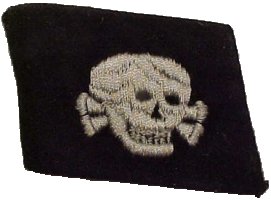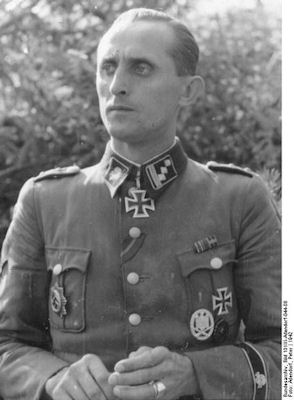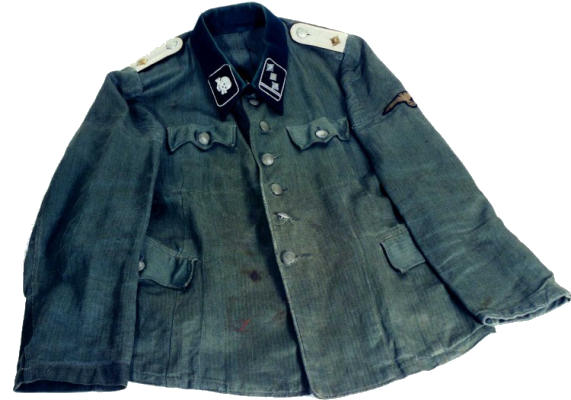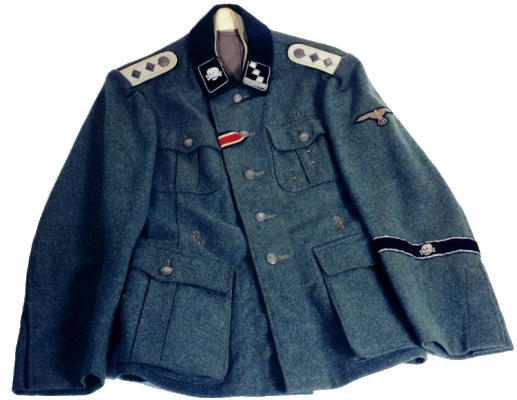Published: 17 December 2010Last Updated: 09 June 2013
The 3. SS-Panzer-Division Totenkopf was formed October 1939 from concentration camp guards of the SS-Totenkopfverbände with the addition of officers from the SS-Verfügungstruppe (SS-VT) and men from SS-Heimwehr Danzig.
Generaloberst Fedor von Bock visited the division on 19 April 1940 and later wrote:
The combat readiness of the SS non-commissioned officers and squadrons in insufficient. We will pay for that with unnecessary blood-shedding! It’s a pity to waste such wonderful human resources. (5)
It was initially held in reserve during the campaign in the west, but was soon sent to the front in Belgium. They suffered heavy losses compared to other units but managed to keep up the advance. It later fought in France seeing its only real action against colonial troops at Tarare.
It took part in the invasion of the USSR attached to Heeresgruppe Nord and advanced through the Baltic states and towards Leningrad.
Generalmajor Otto Lancelle, commander of 121. Infanterie-Division, on 5 July 1941 made an official complaint to LVI Panzerkorps about the behaviour of SS-Totenkopf-Infanterie-Regiment 1 during the capture of Kraslau (Krāslava), including looting and unprofessional behaviour during the assault itself leading to unnecessarily high losses among the German troops.
It remained in the Leningrad area until the Soviet counteroffensive pushed the Germans back and it was encircled at Demyansk January to March 1942 when it broke out. It remained on the front until it was transferred to France October 1942 where it regrouped. It was sent back to the Eastern front where it fought at Kursk and Kharkov. It was sent to Hungary December 1944 where it took part in the failed attempt to relieve Budapest.
It surrendered to US forces in Austria, but was promtly turned over to the Soviets and few survived.
Known war crimes
Soldiers from SS-Totenkopf-Infanterie-Regiment 1 killed 92 civilians in Aubigny-en-Artois in France 22 May 1940. (4)
45 civilians in Vandelicourt / Berles-Montchel were killed by soldiers from SS-Totenkopf-Infanterie-Regiment 2 22 May 1940. (4)
Soldiers from SS-Totenkopf-Infanterie-Regiment 1 and SS-Pionier-Bataillon Totenkopf killed 48 civilians in Beuvry 24 May 1940. (4)
On 27 May 1940 at Le Paradis 4th company of the 2nd regiment, commanded by SS-Obersturmführer Fritz Knöchlein, killed 100 Brittish POWs.
Soldiers from Totenkopf were involved in the killings of black French colonial POWs at Lyon during the invasion of France 1940. (3)
Generalmajor Otto Lancelle, commander of 121. Infanterie-Division, on 5 July 1941 made an official complaint to LVI Panzerkorps about soldiers of SS-Totenkopf-Infanterie-Regiment 1 looting the town of Kraslau (Krāslava) after it was captured by the German forces.
Lineage
SS-Totenkopf-Division (1939 – 1942)
SS-Panzergrenadier-Division Totenkopf (1942 – 1943)
3. SS-Panzer-Division Totenkopf (1943 – 1945)
Commanders
SS-Obergruppenführer Theodor Eicke (1 Nov 1939 – 7 July 1941) (1)
SS-Obergruppenführer Matthias Kleinheisterkamp (7 July 1941 – 18 July 1941)
SS-Obergruppenführer Georg Keppler (18 July 1941 – 19 Sep 1941)
SS-Obergruppenführer Theodor Eicke (19 Sep 1941 – 26 Feb 1943) (2)
SS-Gruppenführer Max Simon (26 Feb 1943 – 27 Apr 1943)
SS-Gruppenführer Heinz Lammerding (27 Apr 1943 – 01 May 1943) (acting for Max Simon)
SS-Obergruppenführer Hermann Priess (01 May 1943 – 10 Oct 1943) (acting for Max Simon)
SS-Obergruppenführer Hermann Priess (10 Oct 1943 – 20 Jun 1944)
SS-Oberführer Karl Ullrich (20 Jun 1944 – 13 Jul 1944)
SS-Brigadeführer Helmuth Becker (13 Jul 1944 – 08 May 1945)
Chief of Staff
SS-Oberführer Cassius Freiherr von Montigny (? Oct 1939 – 24 May 1940)
SS-Sturmbanführer Paul Geisler (24 May 1940 – 5 June 1940)
SS-Brigadeführer Kurt KnobLauch (5 June 1940 – 20 Dec 1940)
SS-Obersturmbannführer Heinz Lammerding (20 Dec 1940 – 26 Apr 1943)
SS-Sturmbannführer Rudolf Schneider (27 Apr 1943 – ? June 1943)
SS-Sturmbannführer Baldur Kelelr (? June 1943 – 1 Oct 1943)
SS-Obersturmbannführer Erich Eberhardt (22 Oct 1943 – 1 Mar 1945)
Quartermaster
SS-Sturmbannführer Paul Geisler (? Oct 1939 – ? Jan 1941)
SS-Hauptsturmführer Rudolf Schneider (15 Jan 1941 – 9 Nov 1942)
SS-Sturmbannführer Heinz Hufebach (9 Nov 1942 – 22 Jan 1944)
SS-Sturmbannführer Dr. Marin Weidlich (1 Sep 1944 – 1 Mar 1945)
Area of operations
Germany (Nov 1939 – May 1940)
Belgium & France (May 1940 – June 1941)
Eastern front, northern sector (June 1941 – Oct 1942)
France (Oct 1942 – Feb 1943)
Eastern front, southern sector (Feb 1943 – July 1944)
Eastern front, central sector & Poland (July 1944 – Dec 1944)
Hungary & Austria (Dec 1944 – May 1945)
Manpower strength
May 1940 21.311
June 1941 18.754
Dec 1942 21.186
Dec 1943 15.415
June 1944 21.115
Dec 1944 15.400
Manpower strength (7 April 1945)
44 Officers
87 NCO
873 Soldiers
6 Operational tanks
Honor titles
“Totenkopf” means “death’s head” and this division was named after the concentration camp guards of the Totenkopfverbände (= death’s head units), from which it was built, with the addition of new recruits and transfers from SS-VT units.
One regiment within this division was also named:
SS-Pz.Gren. Regt. 6 „Theodor Eicke“
SS-Obergruppenführer Theodor Eicke (17 Oct. 1892 – 26 Feb. 1943) was infamous as one of the architects of the concentration camp system. The commandant of the Dachau concentration camp and later inspector of concentration camps and death’s head units, he was also in charge of the forming of the Totenkopf-Division, which he commanded until killed on the Eastern Front when his observation plane was shot down near Michailowka.
SS-Pz. Gren. Regt. 5 is often incorrectly listed with the title „Thule“
The Thule-Gesellschaft (= „Thule Association“) was a neo-Germanic, racist and anti-semitic nationalist organization founded in 1918, which used the “sunwheel” swastika, combined with a dagger, as its symbol and was somewhat involved in the founding of the Nazi Party. The name “Thule” as such refers to a mystical, ancient Nordic high culture, which figured largely in the Nazi belief system.
Holders of high awards
Holders of the Close Combat Clasp in Gold (33)
Holders of the Commendation Certificate of the Commander-in-Chief of the Army (4)
– Meguscher, Johannes, 18.04.1942 (907), SS-Unterscharführer, Nachr.-Staffel Stb./Kradsch.Btl. SS-Totenkopf-Div.
– Rademacher, Theo, 25.05.1942 (1000), SS-Oberjunker, SS-Inf.Rgt. “Totenkopf”
– Schulz, Eberhard, 18.04.1942 (935), SS-Sturmann, 1./SS-Inf.Rgt. 3 “Totenkopf”
– Zollhöfer, Emil, 15.07.1942 (1096), SS-Sturmbannführer, Kdr. I./SS-T Inf.Rgt. 1
Holders of the Commendation Certificate of the Commander-in-Chief of the Army for Shooting Down Aircraft (2)
– Appel, Hans, 28.11.1942 (298), SS-Sturmmann, 4./SS-Totenkopf-Aufkl.Abt.
– Hütt, [first name not listed], 21.08.1944 [Date of Action] (534), SS-Unterscharführer, 4./SS-Pz.Gren.Rgt. 5
Holders of the German Cross in Gold (125)
Holders of the German Cross in Silver (2)
– Schuster, Friedrich-Wilhelm, 15.03.1945, SS-Obersturmbannführer, Div.Ing. K (V) 3. SS-Pz.Div. “Totenkopf”
– Stutz, Dr. Hans, 28.02.1944, SS-Sturmbannführer, Feldlazarett/3. SS-Pz.Div. “Totenkopf”
Holders of the Honor Roll Clasp of the Heer (22)
Holders of the Knight’s Cross (55)
Unit-Level Commendation Certificate of the Commander-in-Chief of the Army for Shooting Down Aircraft (7)
– 1./SS-Totenkopf-Aufklärungs-Abteilung
— Date/Place of Downing: 14.09.1941 bei Tschitschilowo
— Award Date: 29.11.1941 (30)
– III./SS-Totenkopf-Infanterie-Regiment 3
— Date/Place of Downing: 18.01.1942 bei Beglowo
— Award Date: 16.05.1942 (84)
– 2./SS-Totenkopf-Infanterie-Regiment 1
— Date/Place of Downing: 28.02.1942 bei Demjansk
— Award Date: 19.06.1942 (157)
– 1./SS-Totenkopf-Infanterie-Regiment 1
— Date/Place of Downing: 16.03.1942 bei Jeruschkowo
— Award Date: 19.07.1942 (170)
– 4./SS-Totenkopf-Infanterie-Regiment 1
— Date/Place of Downing: 06.05.1942 bei Jeruschkowo
— Award Date: 19.07.1942 (172)
– 4./SS-Totenkopf-Artillerie-Regiment
— Date/Place of Downing: 13.08.1942 bei Kukuj (2 aircraft)
— Award Date: 28.11.1942 (276/277)
– SS-Panzer-Aufklärungs-Abteilung 3
— Date/Place of Downing: 09.03.1944 bei Pantschewo
— Award Date: 01.08.1944 (509)
Order of battle (fall 1939)
SS-Totenkopf-Infanterie-Regiment 1
SS-Totenkopf-Infanterie-Regiment 2
SS-Totenkopf-Infanterie-Regiment 3
SS-Totenkopf-Artilerie-Regiment
SS-Totenkopf-Aufklärungs-Abteilung
SS-Totenkopf-Panzer-Abwehr-Abteilung
SS-Totenkopf-Pionier-Bataillon
SS-Totenkopf-Nachrichten-Abteilung
Order of battle (1941)
SS-Totenkopf-Infanterie-Regiment 1
SS-Totenkopf-Infanterie-Regiment 2
SS-Totenkopf-Infanterie-Regiment 3
SS-Totenkopf-Artilerie-Regiment 3
SS-Panzer-Abteilung
SS-Totenkopf-Aufklärungs-Abteilung
SS-Totenkopf-Nachrichten-Abteilung
SS-Totenkopf-Panzer-Abwehr-Abteilung
SS-Totenkopf-Sturmgeschütz-Batterie (mot)
SS-Totenkopf-Flak-Abteilung 3
SS-Werfer-Abteilung
SS-Totenkopf-Kradschützen-Bataillon 3
SS-Pionier-Bataillon Totenkopf
SS-Sanitäts-Dienste
SS-Totenkopf-Nachubdienste
SS-Totenkopf-Verpflegungsdienste
SS-Totenkopf-Div.-Verwaltungsdienste
SS-Totenkopf-Feld-Ersatz-Bataillon
Order of battle
SS-Panzergrenadier-Regiment 5 (often incorrectly named Thule)
SS-Panzergrenadier-Regiment 6 Theodor Eicke
SS-Panzer-Regiment 3
SS-Panzer-Artillerie Regiment 3
SS-Panzerjäger-Abteilung 3
SS-Sturmgeschütz-Abteilung 3
SS-Flak-Abteilung 3
SS-Werfer-Abteilung 3
SS-Panzer-Nachrichten-Abteilung 3
SS-Panzer-Aufklarungs-Abteilung 3
SS-Panzer-Pionier-Bataillon 3
SS-Dina 3
SS-Feldlazarett 3
SS-Kriegsberichter-Zug 3
SS-Feldgendarmerie-Trupp 3
SS-Feldersatz-Bataillon 3
Notable members
Richard Baer (commandant of Auschwitz)
Fritz Biermeier (usually credited with 31+ destroyed tanks but the exact number is unknown)
Fritz Christen (Credited with singlehandedly destroying 13 Soviet tanks with a 50mm anti-tank gun 24 September 1941 after the rest of the crew had been killed, received the Knight’s Cross on 20 October 1941 as the first Waffen-SS enlisted man)
Theodor Eicke (former Inspector of Concentration camps and commandant of Dachau)
Christian Peder Kryssing (Danish officer who reached the highest Waffen-SS rank of any non-German, SS-Brigadeführer)
Jens Kryssing (son of Christian Peder Kryssing, the highest ranking non-German in the Waffen-SS, KIA 1942)
Karl Leiner (son in law of Theodor Eicke)
Igor Moravec (son of Emanuel Moravec, Minister of Education and National Enlightenment in the government of the Protectorate of Bohemia and Moravia)
Jürgen Stroop (infamous for his role in the crushing of the Warsaw uprising)
Officers serving in the Einsatzgruppen and Concentration Camps
Concentration Camps 159
Einsatzgruppen 1
(includes officers serving in the Einsatzgruppen or Concentration Camps either prior to or after service in this unit)
Insignia
The tactical marking of the division was a white skull with crossed bones, normally the skull was facing left.
The “Totenkopf” cuff title was authorized for this unit on 1 September 1942.
The “Theodor Eicke” cuff title was authorized for SS-Panzergrenadier Regiment 6 Theodor Eicke in March 1943.
The “Thule” cuff title was authorized for SS-Panzergrenadier Regiment 5 in 1942. It was ordered to be discontinued in 1943 but was used until the end of the war.
A totenkopf collar was initially worn by all members of the division, in vertical format until May 1940 and then in horizontal format.

(Courtesy of The Ruptured Duck)
SS-Obersturmführer Walter Gerth wearing the vertical pattern collar tabs

SS-Hauptsturmführer Max Seela wearing the horizontal pattern collar tabs and the totenkopf-cuff title which was used by SS-Totenkopfverbände, not the Totenkopf division

Other militaria
This is an Army enlisted tunic dated 1940 of a SS-Hauptsturmführer and the hand-embroidered silver bullion skull collar tab is of the early (SS-Totenkopfverbände) variety, as well as the skull cuffband. It was drawn from Army supplies in 1940 when the Totenkopf and SS-Polizei-Divisions were being assembled during the Western Campaign. Many officers who were field commanders often took enlisted tunics and wore them, often with modifications.

(Courtesy of Willi Schumacher)
This is a herring bone twill drill jacket used by the troops when in garrison. During the hot summers in Russia, these were often worn in the field. This particular jacket has many interior modifications. There are indications of twin upper pockets including a scalloped pocket flap; however, there are no pockets. The officer had a dark-green wool collar appended to the jacket with officer-quality insignia including a hand-made silver bullion skull collar tab of the Totenkopf Division variety. The SS styled shoulder boards are sewn into the sleeve seams and the sleeve eagle is of the machine woven style (often referred to by collectors as Bevo).

(Courtesy of Willi Schumacher)
Propaganda
A example of the propaganda produced about the division: “Damals: Erinnerungen an Grosse Tage der SS-Totenkopf-Division im Französischen Feldzug” (1940).
In fiction
The novel “SS General” by Sven Hassel depicts SS-Obergruppenführer Theodor Eicke, the commander of the Totenkopf Division, conducting a rather implausible inspection of the 6. Armee at Stalingrad.
The 2004 board game “Clash Along the Psel: The Battle of Kursk 1943” designed by Ray Tapio and published by Critical Hit focus on the fighting on the Psel.
Footnotes
1. SS-Obergruppenführer Theodor Eicke was wounded 7 July 1941 by a Soviet mine that blew up his command car.
2. SS-Obergruppenführer Theodor Eicke was killed 26 February 1943 when his Fieseler Storch aircraft was shot down by Soviet ground fire.
3. “Murderous Elite: The Waffen-SS and its complete record of war crimes” by James Pontolillo, page 74 and “Hitler’s African Victims: The German Army Massacres of Black French Soldiers in 1940” by Raffael Scheck.
4. “La campagne de 1940” by Christine Levisse-Touzé.
5. “Totenkopf 1939-1943” by Jacek Solarz, page 18.
Sources used
John R. Angolia – Cloth insignia of the SS
Roger James Bender & Hugh Page Taylor – Uniforms, Organization and History of the Waffen-SS, vol 2
Georges M. Croisier – Waffen-SS (PDF)
Terry Goldsworthy – Valhalla’s Warriors: A history of the Waffen-SS on the Eastern Front 1941-1945
Dr. K-G Klietmann – Die Waffen-SS: eine Dokumentation
Christine Levisse-Touzé – La campagne de 1940
Peter Lieb – Konventioneller Krieg oder NS-Weltanschauungskrieg?: Kriegführung und Partisanenbekämpfung in Frankreich 1943/44
Kurt Mehner – Die Waffen-SS und Polizei 1939-1945
James Pontolillo – Murderous Elite: The Waffen-SS and its complete record of war crimes
Marc J. Rikmenspoel – Waffen-SS Encyclopedia
Raffael Scheck – Hitler’s African Victims: The German Army Massacres of Black French Soldiers in 1940
Raffael Scheck – “They Are Just Savages”: German Massacres of Black Soldiers from the French Army in 1940, Journal Modern History 77, Nr. 2 (2005), pp. 325-344
Jacek Solarz – Totenkopf 1939-1943
George H. Stein – The Waffen-SS: Hitler’s Elite Guard at War 1939-1945
James C. Steuard – Tactical Markings of the Waffen-SS, Part 2 (in AFV-G2 Vol 4 No 4)
Charles W. Sydnor – Soldiers of Destruction: The SS Death’s Head Division, 1933-1945
Frank Thayer – Waffen-SS unit collar insignia (in The Military Advisor, Vol 5 No 2)
Gordon Williamson & Thomas McGuirl – German military cuffbands 1784-present
Gordon Williamson – The Waffen-SS: 1. to 5. Divisions
Mark C. Yerger – Waffen-SS Commanders: The Army, corps and divisional leaders of a legend (2 vol)
Reference material on this unit
Massimiliano Afiero – Totenkopf: la divisione ‘Testa di morto’ della Waffen SS
Herbert Brunnegger – Saat in den Sturm: Ein Soldat der Waffen-SS berichtet
Rupert Butler – Hitler’s Death’s Head Division: SS Totenkopf Division
Jack Holroyd – SS Totenkopf France 1940: Images of War
Roger Hunt – Death’s Head: Combat record of the SS Totenkopf Division in France, 1940 (translation of a book published 1942)
Cyril Jolly – The vengeance of Private Pooley
Richard Landwehr – From the Arctic Circle to the Don River: SS Regiment “Thule” 1940-1943
Eric Lefevre – SS Totenkopf: France 1940
Chris Mann – SS-Totenkopf: The History of the ‘Death’s Head’ Division 1940-45
Martin Månsson & Charles Trang – Thule: SS-Infanterie Regiment 9
Wolfgang Schneider – Tiger der Division ‘Totenkopf’
Jacek Solarz – Totenkopf 1939-1943
Charles W. Sydnor – Soldiers of Destruction: The SS Death’s Head Division, 1933-1945
Paul Thomas & Stephen Andew – March of the Death’s Head Division
Uwe Timm – In My Brother’s Shadow: A Life and Death in the SS
Charles Trang – Totenkopf
Karl Ullrich – Like a Cliff in the Ocean: The History of the 3. SS-Panzer-Division “Totenkopf”
Karl Ullrich – Wie ein Fels im Meer: Bildband
Vopersal – Soldaten, Kämpfer, Kameraden (9 vol)
Michael Wood – Tigers of the Death’s Head: SS Totenkopf Division’s Tiger Company



